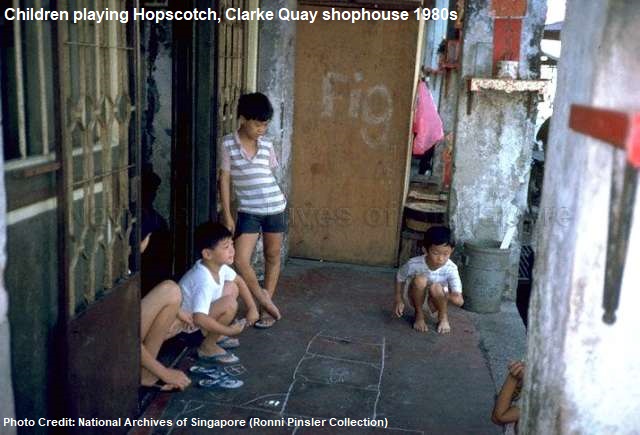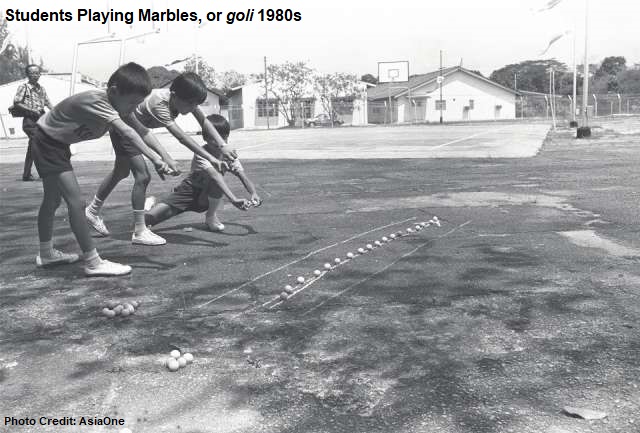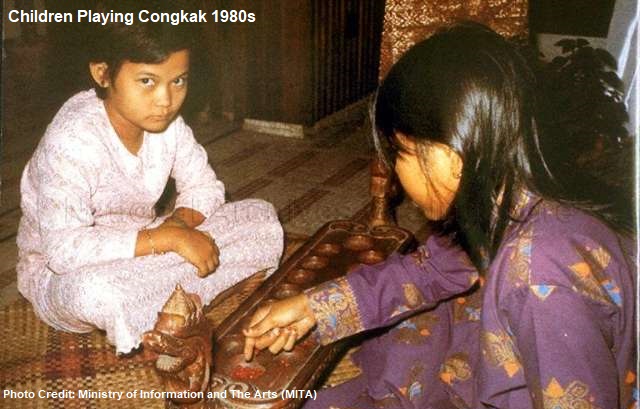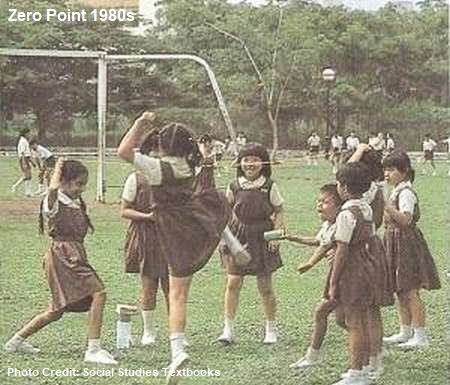Large open spaces, some creativity, lots of stamina, and simple improvised materials using sticks, stones, tin cans. All these added to the recipe for games that provided hours of fun and joy for the kids of the past. Catching, police and thief game and hide-and-seek had ruled the playgrounds long before the electronic games conquered the kids’ world.

There were also the “lastic” wars. Popular among the boys who would arm themselves with elastic bands and multiple paper missiles, and take joy in aiming at each other. Sometimes, the targets were switched to wary cats or birds on the trees, or that poor old unsuspected bakut man who was peddling his feather dusters, brooms and other household items in the neighbourhood.
 Girls, on the other hand, loved to play “long long“, a variation of hide-and-seek, where the hider attracted the seeker’s attention by shaking a cigarette tin filled with pebbles.
Girls, on the other hand, loved to play “long long“, a variation of hide-and-seek, where the hider attracted the seeker’s attention by shaking a cigarette tin filled with pebbles.
Soon, the kite season would come, and the kids would be busy making their layang-layang (kites in Malay). Some mischievous ones would use their mothers’ precious pestles and mortars to pound the glass into powder in order to make glass strings so that they could cut off their rivals’ kites.
What other games were popular in the sixties, seventies and eighties?
Gasing
Gasing was a top spinning game that was once extremely popular in Singapore and Malaysia, especially among the Malay communities. Typically made of hardwood, the spinning top, also called gasing, comes in different variations, sizes, weights and shapes – the most popular being the egg-shaped, heart-shaped and saucer-shaped.

The history of gasing goes back to the Malacca Sultanate (1400-1511), when it was said to be the favourite game among the rice farmers. In Singapore, kampongs used to play and compete against each other, but by the late seventies, the game’s popularity had begun to dwindle. In 1979, the Singapore Gasing Federation was established in a bid to revive the interest in this traditional game.

Gasing courts (different sizes of 5m by 5m and 9m by 9m) were built in new towns such as Clementi and Eunos, and championships were held in the eighties. In most competitions, gasing pangkah was played, where the player had to hit his opponent’s top and knock it out of the circle and stop it from spinning. Another type of challenge was gasing un – to keep the top spinning for as long as it could.
 Horselegs
Horselegs
Known as kaki kuda or tapak kuda in Malay, the Horselegs game was played by challenging one’s balance while standing on empty tin cans.
This simple traditional game was once popular in the sixties and seventies among the kids, who would play in a rhythmic bout of dance with lip a-chanting and feet a-tapping. It gradually disappeared when the kampongs were replaced by the new towns and public flats after the late seventies.
In 1979, the Horselegs game was part of Singapore’s 46 traditional games exhibited in the National Museum Young People’s Gallery.
Bola Tin
The game of bola tin required two teams to play, namely the keepers and throwers. A stack of empty condensed milk tin cans, any quantity between 10 and 20, formed a pyramid at the centre between the two teams.
 Behind a drawn line roughly ten steps away from the stack of tin cans, a thrower would try to knock them down with a ball. Each thrower was allowed with two tries. Once the stack of tin cans was hit, both teams would scramble for the ball.
Behind a drawn line roughly ten steps away from the stack of tin cans, a thrower would try to knock them down with a ball. Each thrower was allowed with two tries. Once the stack of tin cans was hit, both teams would scramble for the ball.
The keepers would try to rebuild the pyramid, and, given the chance, throw the ball as far as they could. The throwers, if they had gotten the ball, would aim at any of the keepers, who would be disqualified once they were hit.
When the throwers succeeded in hitting all the keepers, they would win the game. On the other hand, the keepers would win if they finished rebuilding the pyramid before all of their members were forced out of the game.
Hantam Bola
Another bola game was the popular hantam bola typically played among the boys.
Literally means hitting or walloping with a ball in Malay, the game was similar to the modern Dodgeball. Usually played in a large field, the “thrower” would try to hit the others with a tennis ball, while the rest of the players would be running away and avoiding getting hit. The player who was hit would become the “thrower” himself.
The name hantam bola actually appeared much earlier, in the early 20th century, during cricket games, when a popular jingle “kaptan kita Tuan Berchie. Hantam bola banyak tinggi” was sang to applaud the skills of a famous cricketer.
The longevity of hantam bola lasted well into the nineties, when many primary and secondary students were seen playing the game in their school fields during recess periods.
 Trivial: The “Court Martial” was an elaborated version of hantam bola. Armed with stones, each player would have to dig a small hole in the field, and then took turns to roll the tennis ball into the hole. If the ball fell into the hole, the thrower had to retrieve it and try to hit the others who would be running away.
Trivial: The “Court Martial” was an elaborated version of hantam bola. Armed with stones, each player would have to dig a small hole in the field, and then took turns to roll the tennis ball into the hole. If the ball fell into the hole, the thrower had to retrieve it and try to hit the others who would be running away.
Anyone who was hit would put a stone into the hole he had dug. Once it reached three stones, the losing player would be “court martialled”, where he had to stand still and let the other players hit him three times with the ball.
Bola Lubang
Bola lubang was another ball throwing game played by several players. Each player would have a hole dug in the ground. The first player would throw a ball, from a distance, towards the holes; if it entered one, he would quickly have to retrieve the ball and throw against the running player who “owned” that hole. If hit, that player would be out of the game. If missed, the next player would be the “thrower”.
Hopscotch
The children’s pavement game was said to have originated from the Roman Empire era, and became popular in England in the 17th century. After the Second World War, the game made a comeback in London, and its popularity soon spread to Malaya and Singapore.
Hopscotch was often called teng teng locally. The game was played by drawing nine numbered squares on the ground – either scratched out on dirt grounds or with a chalk on concrete floors – and using pebbles or stones to “reserve” the squares. Due to the airplane-like outline of the square diagram, it was also known as the Aeroplane game.

In the game, each player would have to hop, skip and turn around, throwing his or her stones onto the squares to “occupy” them. According to the rules, the players could not hop onto an “occupied” square or stepped onto the outlines of the diagram. At the ninth square, often in the shape of a semi circle instead, the player would have to turn around and pick up the stone without seeing it. The first player to complete the game would be the winner.
 A more challenging version, called Snail Hopscotch, was also played by the local kids in the seventies. In this version, pebbles or stones were not used. The player would have to hop on one foot through the “snail” until he came to the centre semicircle marked “rest”, where he could place his two feet on the ground.
A more challenging version, called Snail Hopscotch, was also played by the local kids in the seventies. In this version, pebbles or stones were not used. The player would have to hop on one foot through the “snail” until he came to the centre semicircle marked “rest”, where he could place his two feet on the ground.
The player continued the game by hopping in the reverse direction out of the “snail”. Upon completion, he could write his initials on chosen square. In his next turn, he could rest in that square with two feet. However, for the other players, they had to hop over that “reserved” square. They would have to win their own squares.
Goli
Marbles, or goli, was one of the favourite games among the boys. One of the common ways to play marbles was to draw a circle on the dirt ground, where all the players’ marbles were placed in it, and a straight line drawn several steps away. Each player would then stand behind the line and use his marble to hit the group of marbles inside the circle. If the player hit the marbles, he could win and keep those that fall out of the circle.
The marbles came in different designs and sizes; the most popular ones were the transparent types. In the eighties, there were also the solid clay marbles and stainless steel ones (called tee zee in Hokkien), where the boys found joy in smashing their rivals’ marbles into pieces.


The goli game also came in different variations, some even involved gambling elements, in the later years. For example, instead of marbles, Panini stickers, coins or even dollar notes were placed as stakes in the drawn circle. The player who managed to hit them out of the circle with his marble would pocket the winnings.
Congkak
Congkak, or jongkak, was a traditional game usually played by two people, using tamarind seeds and a rectangular board that had a central partition, seven holes on each side and a receptacle at each end. The holes were known as “huts” and the receptacles were “storehouses”, where the players could fill with as many seeds as possible.

At the start of the game, the player would sit opposite of each other, where they each had seven “huts” and a “storehouse”. Each “hut” would be filled with seven tamarind seeds, while the “storehouse” was left empty.
The first player started the game by scooping the seeds from his extreme right “hut”, and deposited them, one in each “hut”, in a clockwise direction. The last seed would be dropped into his “storehouse”. Then he continued by scooping the seeds from any of his “huts” and dropped them in the same manner, including his opponent’s “huts”. During the game, he could deposit the seeds in his “storehouse” but bypassed his opponent’s “huts”.
 The game carried on until his last seed was dropped into an empty “hut”. If so, he could take all the seeds from the opposite side of that empty “hut” and transferred them to his “storehouse”. It would then be the opponent’s turn to play.
The game carried on until his last seed was dropped into an empty “hut”. If so, he could take all the seeds from the opposite side of that empty “hut” and transferred them to his “storehouse”. It would then be the opponent’s turn to play.
During the game, any empty “huts” when the player’s turn was over would be considered a burnt “hut”. A crumpled piece of paper would be put inside, and no seeds could be deposited in it. At the end of the game, the player with the most seeds in his “storehouse” would be the winner.
Kaunda-Kaundi
The kaunda-kaundi was another old traditional Malay game. It was simply played using two hibiscus stems – one long and one short. The shorter stem would be placed, at an angle, on a piece of wood. Each player would use the long stem to hit the shorter stem twice – first to make it bounce up into the air, and again to hit it as far as he could.
Meanwhile, the opponent would try to catch the short stem before it landed on the ground. If he managed to do that, then the first player would lose. Otherwise, the winner would be the one who hit the short stem furthest.
Kuti-Kuti
Kuti-kuti was an old flipping game said to have been played by local kids since the 1940s. At the beginning, the game was played using circular discs. By the seventies and eighties, it had evolved into a flipping game using colourful plastic pieces in the shapes of different animals such as elephant, deer and fish.

The rules for kuti-kuti were simple. The player would take turns to flip his plastic pieces over his opponent’s. If his piece landed on top of his opponent’s piece, he would win and claim it as his own. If not, the turn would be passed over to his opponent. The game ended when one party won all the pieces.
There were several variations of kuti-kuti, when players used bottle caps or erasers that were printed with flags of different nations.
Capteh
It would take good balance and quick reaction to play capteh. Using a shuttlecock or a band of feathers attached to a round rubber base, each player would have to kick the capteh as many times as he could, without it touching the ground.
 The player would be allowed to have his kicking foot touched the ground only once every kick. The one who had the most kicks would be the winner.
The player would be allowed to have his kicking foot touched the ground only once every kick. The one who had the most kicks would be the winner.
Capteh has been promoted and played recently in 2016 as one of the Sports Hub Community Play Day activities at the new National Stadium.
Encang Kuda
Also known as keleret, Encang kuda, or horseback in Malay, was a piggyback riding game in which two players played as “jockey” and “horse”. At the start of the game, both “jockey” and “horse” would throw their stones at a pre-drawn straight line on the ground. The one whose stone was nearer to the line got to ride the other player on the back.
The “horse” would then pick up the two stones and handed them to the “jockey”, who would throw one stone and let the “horse” throw the second. If the “horse” accepted the challenge and hit the stone, he would be the winner. If the “horse” rejected the challenge, the “jockey” would have to hit the stone himself. If he succeeded, the “horse” would need to continue piggyback him. The game ended if he missed, and restarted with a second round.
Five Stones
Played in many Asian countries, the five stones game, as its name implies, was played using five small pieces of granite pebbles. In Singapore, after the sixties, it was played using five small pyramid-shaped cloth bags filled with rice, sand or seeds.
 Popular among the girls, two or more could play the five stones game. The game began with all the five stones on the ground. The first player would have to throw the first stone up in the air, pick up the second stone, and catch both with the same hand. Then she would throw the third stone up in the air and catch all three stones. This continued until she had all five stones in one hand.
Popular among the girls, two or more could play the five stones game. The game began with all the five stones on the ground. The first player would have to throw the first stone up in the air, pick up the second stone, and catch both with the same hand. Then she would throw the third stone up in the air and catch all three stones. This continued until she had all five stones in one hand.
The second round was slightly more challenging. The player would have to hold on to two stones after throwing one up. Similar rule applied to the difficult third round and fourth round, except that the player had to grip three and four stones respectively at one go.
There was another level where the player needed to throw a stone up and quickly exchange the stones in her hand and the ones lying on the ground. If, at any one time, the stone fell onto the ground without her catching it, it would be considered a miss for the first player, and the turn would be passed to the second player. Whoever could complete the sequence successfully win the game.
Zero Point
 Zero point was another girls’ favourite game. The game typically involved skipping over the elastic rope that was made up of many rubber bands linked together.
Zero point was another girls’ favourite game. The game typically involved skipping over the elastic rope that was made up of many rubber bands linked together.
At least three girls were needed to play the zero point – two holding the elastic rope on each end, and one carrying out the challenges. One of the common rules would be skipping over the rope held by the two girls at their knee, waist, shoulder and head levels.
The zero point game was particularly popular in schools in the eighties and nineties. While the boys played marbles or hantam bola on the field, the girls would play zero point along the corridors.
Hoop Wheeling
The hoop wheeling was a game played by competing teams or individual players.

Each player would be using a stick to push and roll an aluminum rim forward over a designated distance. The aluminum rim had a groove along its circumference that guide the stick.
If the aluminum rim fell along the way, the player had to stop and re-balance the rim with his stick to continue. The first player to reach the finishing line would win the game.
Hoop wheeling was often played in kampongs and later in schools during carnival events. Speed and a good sense of balance and control were keys in winning the game.
Galah Panjang
The popular traditional Malay game was typically played on a dirt field, where grid lines were drawn, or a badminton court. At least eight players – four attackers and four defenders – would be required to play galah panjang.
To start the game, the attacking players would have to be always within the boundary, where they could launch their offense individually or as a group, depending on their strategy. The leader of the defending team would guard the centre line whereas his members guarded each parallel line respectively.
The attackers would then try to breach the defensive lines without being touched by the defenders. He or she would be out of the game if touched. If at least one attacker managed to break through the defenders’ line, the attacking team would win the game, and the roles between the teams swapped.
Other Games
 The other games played by the kids of the sixties, seventies and eighties included Broken Telephone, Rounders, Statues and Tick Tock (Tic Tac Toe).
The other games played by the kids of the sixties, seventies and eighties included Broken Telephone, Rounders, Statues and Tick Tock (Tic Tac Toe).
The Cat’s Cradle string game, in particular, was popular in schools in the eighties.
Most of these traditional games had faded away by the eighties, due to the rapid disappearance of kampongs and the rise of electronic games in arcade and computers. In the early eighties, the People’s Association (PA) taught children at the community centres how to play the traditional games, and even held various game competitions at the national level.
 In 1984, the Singapore Broadcasting Corporation’s (SBC) Children and Educational Unit also launched a TV programme called O-Bay-Som (name inspired by the local children’s team selection orh-yah-beh-yah-som in a game) to introduce the traditional games to the new “Computer Age” generation.
In 1984, the Singapore Broadcasting Corporation’s (SBC) Children and Educational Unit also launched a TV programme called O-Bay-Som (name inspired by the local children’s team selection orh-yah-beh-yah-som in a game) to introduce the traditional games to the new “Computer Age” generation.
The efforts, however, did little in stopping the traditional games from gradually fading away into history.
Trivia: While we had o-bay-som (literally means black and white in Hokkien. Players with palms facing down would be grouped together, the other team would be those with palms facing up) or lom-chiam-pas (similar to scissors-paper-stone) for team selection during a game, the Indonesian kids used the Elephant, Man and Ant. For the Thais, Mai San Mai Yao was preferred, where players picked sticks of different lengths to determine their teams.
How many of the traditional games do you remember?
Published: 27 January 2018








Here’s more that I can still remember: kayu canang, sep sep (save save), pok balok balok, skipping, sepak raga, raga bulat, tiam tiam pak, masak masak, bola baling, main layang layang (kites), main panah (arrows and bows made of bamboo), main tombak (spears), main pedang (sword fighting, swords were made from hibiscus stems and the loop/knuckle guards were made from dried coconut husks), main tembak tembak (with batalon used as bullets) and main sumpit (blowpipe). In the kampong we used to live in (Kampong Lorong Renjong, Singapore 19), games were triggered by the theme of the open air movies shown every fortnightly. A western (cowboy) movie would get the children to ‘main tembak tembak’ and if the movie shown was about ‘Robin Hood and his Merry Men’, children will start making spears and swords and so on.
Is there a specific season when kite flying is/ was more frequent? Or is it just whenever the weather allows?
Dear Sir/ Madam,
I am Tan Jiayi, a student from Ngee Ann Polytecnic’s Tourism and Resort Management. As part of our curriculum, my team is organizing an event at Yuhua Constituency on the 28 of July 2019. Hence, I am writing in to seek permission on using your photos and write ups of this article as we are planning to display them at our panel booth on the event day. Should you have any queries, please do not hesitate to email me. Hope that you can consider our request and we sincerely look forward to your favourable reply.
Best Regards,
Tan Jiayi